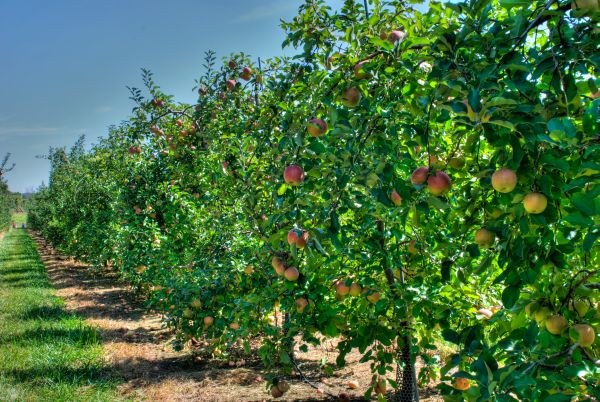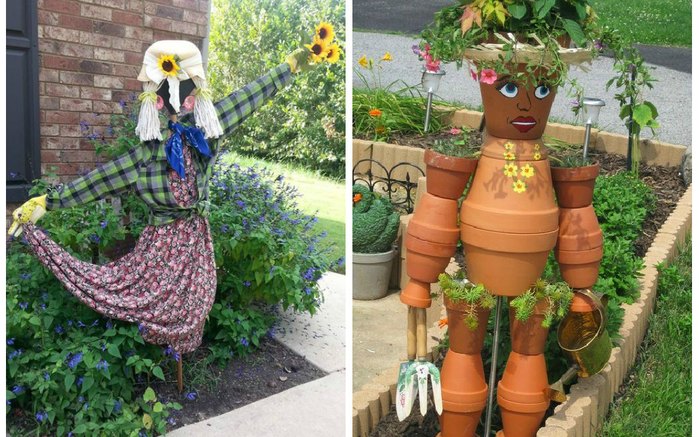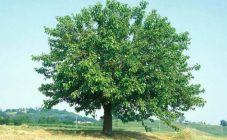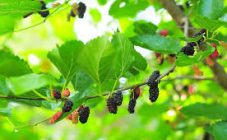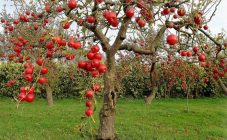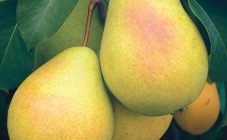Content:
Every gardener knows how important it is to care for fruit trees so that they give a harvest. Especially when the purpose of growing is sale, but it will also be nice to collect large and tasty fruits for yourself.
How to care for fruit trees
Fruit trees need to be cared for every year throughout their life. It consists in crown formation, removal of root growth, protection from diseases and pests. It is also necessary to ensure that unfavorable climatic conditions do not affect the life of the tree.
Whitewashing the trunk
Before the sun begins to bake intensively in the spring, the trunks are treated with milk of lime or other means. Thanks to this measure, they do not overheat from the sun, which is especially detrimental in combination with low night temperatures, while the warm weather has not yet settled down. This is especially important for northern regions such as Siberia. This, too, is the maintenance of fruit trees in the spring.
The most effective way to repel rodents and pests is to whitewash the trees. This measure will also protect well against disease. The best time for processing is spring or autumn. Autumn whitewashing is done at the end of October and plays an important role in caring for the tree:
- Reflects sunlight - prevents overheating, leading to cracks and drying out of the trunk.
- Protects against temperature extremes, which often occur in winter lately.
Modern mixtures kill harmful microorganisms, bacteria, harmful insects, perfectly protect against hares and other rodents.
Having figured out when to whitewash garden trees, you need to choose a suitable day. The most favorable temperature for whitewashing is about 10 ° C, the day should be dry and without bright sun.
How to protect a tree from frost cracks
The most dangerous time for fruit trees is the end of winter. At this time, the sun is already warming up, and frosts at night still happen to everyone. As a result of such abrupt changes, frostbite is formed - cracking of the bark. This happens because under the influence of spring heat, the sap begins to move in the tree trunk, and during frost it freezes sharply, expanding and destroying the bark.
These injuries are irreversible, that is, they never heal, but only increase in size. By itself, frostbite weakens the tree, leading to various diseases. The barrel loses its resistance to external factors.
The following complications may occur:
- frost crayfish - thickening on the trunk next to cracks, it happens in open or closed forms;
- black cancer is a fungus that causes trunk rot in the center of a tree;
- necrosis - the dying off of the bark, other negative factors are superimposed on the frostbites.
It is very difficult to treat frost cracks, therefore it is recommended to whitewash the trunks on time. If the trouble does happen, there are several recommendations. Many gardeners smear the damage with garden varnish, this helps to disinfect the wound. A more effective way is treatment with Runnet disinfectant. The procedure is performed when there is no longer any active movement of the juice in the trunk. The edges of the wound are processed and leveled. After treatment, trees are fertilized in half less, and at the end of summer it is better to stop feeding altogether.
How to attract bees to fruit trees for pollination
All fruit trees need pollination for the greatest yields. In a broad sense, in the middle lane, pollinators are bees, bumblebees, beetles, butterflies, hornets, wasps. In fact, the effect is only from the presence of bees - their body has villi that capture pollen, and this insect works constantly, without stopping to fly from tree to tree. That is why all the efforts of gardeners are aimed at attracting bees.
Insects will not start working if the temperature is below 12 ° C or above 35 ° C. Rain or strong gusts of wind will also be an obstacle. The pollination source should be located no further than 4 km from the hives.
Even if there are already many bees in the garden, it makes sense to attract even more of them. This will noticeably affect the harvest. It is important to ensure that the bees do not fly away. The easiest way to lure bees into the garden is to plant flowering plants that attract insects. Thus, the bees, arriving at the scent of flowers, will also be engaged in pollination of fruit trees. On the outskirts of the garden, you can plant lilacs, and inside - low flowers.
It must be understood that bees do not like pesticides. And here there will be a choice: either to fight pests with chemistry, or to take care of the bees and use natural remedies in the fight. It is better to exclude spraying with chemicals.
There are examples when beekeeping and gardening are combined - hives are placed directly near trees. This method to attract bees is quite laborious. We need to buy a hive with bees and place it no further than half a kilometer from the tree. This will ensure a good harvest.
There is even a technology for preparing bees for pollination. When flowering begins, flowers are collected from the crops that are planned to be most intensively pollinated and mixed with syrup, give the bees a try. A few such morning feeds - and the bee gets used to it, starting to look for the source of this taste. This will no doubt increase the efficiency of using the bees for pollination.
Furrowing
Now gardeners use the furrow method with caution. It consists in the fact that early in the spring, cuts are made on the bark, thereby preventing its spontaneous rupture. The bark can break as a result of the growth of layers of wood. The slots are applied to the trunk or branches with a dotted line - an incision of 15 cm, a gap of 2 cm, the pitch around the circumference should be approximately 7 cm.
The procedure is carried out once every 2 years, in April or May. Then there will be an effect and one can expect that the trunk and branches will become thicker, and fruiting will become more regular.
Scaring away birds
Birds undoubtedly wreak havoc on crops by picking berries. Gardeners have come up with more than one way to deal with them. They are all different in complexity and efficiency, so everyone chooses something for himself. The most common ways to protect berries:
- Rustling subjects... This can be anything from plastic bags or ribbons. The main task of such items is to make noise when a gust of wind blows. This will scare birds away.
- Shiny the elements... These can be pieces of foil, New Year's rain, and similar reflective items. The bird will fly away.
- Shelter mesh... Small or young trees are covered with a special material or mesh with fine meshes. Plants will receive light, but birds will not get to the berries.
- Turntables... Both ready-made and home-made versions are used, they are even made from plastic bottles.
- Application special appliances... There are many electronic bird scaring devices on the market today. They do not pose a danger to humans, and birds are scared away by alarms or bright light.
- Gas cannons... They simulate a shot of a gun after a certain period of time. It is better to use this method if the trees grow far from the house, otherwise you can scare not only birds.
- Scarecrow... In this case, it should be a dummy of a large bird of prey.
Tree cuts
Any wound on a tree, even if it looks like a straight saw cut, needs to be treated, otherwise it may be damaged by fungi and bacteria. A torn wound from a broken branch or a place where the bark has been torn off is especially dangerous. Therefore, it is worth paying attention to any problem area.
In winter, the saw cut is not made, but in the fall, spring and summer you can. It is rainy in autumn, so the cut sometimes takes a long time to dry. In the spring, the wound dries up in just a couple of days. If pruning occurs in summer, young shoots are removed without any treatment. Slices up to 3 cm in diameter need to be disinfected, but they are not covered with anything. But cuts of 3 cm or more are processed as follows:
- immediately after the saw cut, the wound is cleaned of irregularities, burrs;
- well coat the cut with a disinfectant;
- leave for several days until completely dry;
- they are covered with a special compound without going into the healthy part of the wood.
Disinfect with ordinary potassium permanganate, iron sulfate and other means containing copper.
Garden varnish, a mixture of clay and mullein, paints based on natural linseed oil, cement (for large damage), water-based paints, special varnishes are used to cover up the cuts.
Ringing fruit trees
Ringing is nothing more than the removal of a transverse strip of bark. This is a way to speed up fruiting. The procedure involves removing a 2 mm strip in a circle under a branch that is not bearing fruit. The length of the strip should be no more than 4 cm. Thus, buds are promoted for next year's harvest. This happens because nutrients rise up from the roots, and by violating the integrity of the bark, they slow down their backflow, stimulating the development of the branch on which the banding was applied.
If you know how to properly care for fruit trees, each plant will produce the maximum yield. That is, in small areas, you can get good performance not due to the number of plantings, but due to the quality.
